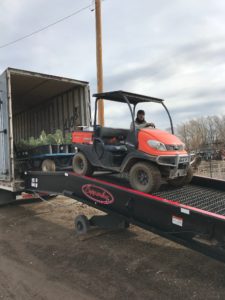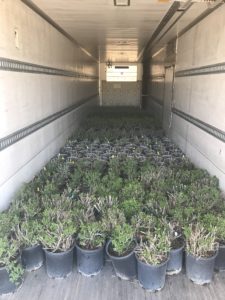
A nursery can grow the healthiest trees. A greenhouse can produce the most beautiful flowers. Businesses can hire successfully to build a strong staff, and market effectively to get customers. But, if the plants can’t get from their operation to their customer’s location, all other efforts are moot.
Developing and maintaining affordable, reliable shipping channels is the key to completing sales successfully. Being properly equipped for loading, transporting and unloading plants efficiently is part of the equation for success as well.
“Most companies in our industry don’t look at freight as a way to make money. It’s just a means we have to accept to get plant material to customers. To do that, we try to keep freight as reasonable as possible,” said Andrew Lisignoli, Sales Manager at Trees of Corrales.
The family-owned, wholesale nursery and growing operation in Corrales, N.M. contracts with trucking companies, and pays them when loads are picked up. That’s why Trees of Corrales bills its customers for shipping and delivery with a 10-day payment period. The payment for the plants can be made within normal terms, but customers are asked to pay for the freight sooner, to cover the upfront cost to the grower.
“Our goal is to break even on freight via out-of-state carriers like Mile Hi Frozen Foods, along with our own deliveries in state,” Lisignoli explained.

The grower ships to its New Mexico and Four Corners area customers with their truck fleet. For Colorado customers on the Front Range, Trees of Corrales has been using Mile Hi for about 25 years. The trucking company grew out of a fruit and vegetable truck farm in Denver. In 1956, it began transporting supplies for the first McDonald’s restaurant in Denver. Today, it provides paper and food products to hundreds of restaurants in the Rocky Mountain region, including Red Robin, Wendy’s, Starbucks, Noodles & Company, Einstein Noah Bagels, Quiznos, and Chipotle.
“Mile Hi is very affordable because of their frequency in delivery and low minimum fees. We don’t have to fill each truck. We can meet the $430 minimum shipment with one or two drops to our customers. With those freight costs, our overall costs to out-of-state customers are similar to local growers,” he said.
Mile Hi can operate with the low minimums because it helps produce income on trucks that would otherwise return to Colorado empty. Over-the-road drivers take trucks full of restaurant supplies from Commerce City and Pueblo to the trailer exchange point near Raton, where that load is exchanged for a load of plants from Trees of Corrales heading to Mile Hi’s distribution hubs. From there they are distributed to the wholesaler’s Front Range customers by Mile Hi’s local drivers.
Once empty, the trucks either return that way to Colorado or they partner with companies like Trees of Corrales that need deliveries along the I-25 corridor. What started as a once-a-week opportunity has now become a regularly scheduled pick-up once or twice a day.

“They drop an empty trailer at our loading dock when they pick up one that is loaded to take to the over-the-road driver heading to the Raton area exchange,” he said. “The over-the-road driver from Denver then takes the load of plants to his terminal in either Commerce City or Pueblo for distribution to our customers by a local Mile Hi driver. We can get two loads a week into Colorado Springs and Pueblo, and five a week to Denver and Fort Collins.”
While the relationship has worked well, regulations restricting truckers’ work hours in recent years have made it less convenient. Drivers are not able to wait long at delivery or pickup points, because they have to get their trucks back to terminals before their regulated shifts end.
“With the new federal regulations, we all need to be cognizant about truckers’ time. A few times in the recent past, the Mile Hi truck driver had to leave before he got unloaded because he was up against his hour limitation. Drivers only have so much time on the clock every day, whether they are driving or waiting around,” he added.
If a driver only has three hours left on his schedule and he gets stuck waiting to unload behind other trucks delivering at a garden center or other customer, the driver may have to leave without unloading to get back to the terminal in time. When the nursery has extra space for the driver to leave an empty trailer and pick it up the next day, that can help.

Even with the challenges of new regulations, Mile Hi has been a consistently reliable trucking partner for Trees of Corrales. The wholesaler uses flatbed truck drivers contracted through VersaFreight of Wheat Ridge, a suburb of Denver, for all other shipments going out of state, including to Texas, Nevada, Arizona and Utah.
“We have tried a few other trucking companies. For a short while, we did a deal with a grocery chain out of Salt Lake City to deliver during their backhauls, but that did not work as smoothly,” Lisignoli recalled.
He knows of one nursery out of Sacramento that ships via Coors trucks. The opportunities are there for anyone wishing to ship out of New Mexico or Colorado, since both are importing states, meaning they net more in-shipments of than out, so trucks often leave the state empty.
Whether looking for a new relationship with Mile Hi or another freight company, he recommends, “Just call up and ask for someone in logistics. More than likely, there are going to be companies delivering into Denver and other areas in our states that are looking for backhaul.”
Other Keys to Shipping Success
Plan for the right loads and procedures whether shipping on enclosed trucks or flatbeds.
- Enclosed trucks have the advantage of protection from the elements, but there is risk of damage to branches during loading and unloading due to the confined space.
- Flatbeds have the advantage of faster loading and unloading, especially for balled and burlapped trees, but the plants are more exposed to the elements as well as highway hazards such as magnesium chloride.
- Enclosed trucks are good for mixed loads, where you can put B&B trees on the tail and containerized plants on racks or floor stacked in the nose.
- If shipping in a refrigerated truck, it must be set at the right temperature to avoid damage to plant material through freezing or shock when it is transferred outside on a hot day. Depending on the season, the temperature control should be set between 45 and 65 degrees Fahrenheit.
- Rare but something to consider, the fabric tube that distributes cold air in refrigerated trucks can break from the top and focus cold air on plants, damaging them.
- Not as many flatbeds are available; they make up only about 10% of the trucks on the road, according to Lisignoli, so are harder to contract.
- Tarping flatbed loads reduces damage from the elements, but purchasing tarps, not getting tarps returned, and shipping back tarps can be costly.
- Breathable nursery tarps are the best option for flatbed shipping. Lumber tarps will suffice during colder weather but they can be heavy and hot.
- Plant damage from tarps can be lessened or avoided by making sure the person putting them on the load knows how to tarp properly.
Be prepared with the right equipment and processes for efficient loading and unloading.
- Plants on racks are quicker for loading and unloading trucks and are damaged less in the process.
- The disadvantage to using racks is they are difficult to return so either take up valuable space at our customers’ locations or increase expenses for return or replacement.
- When loading plants directly on truck floors, it is more efficient to stack plants, but plant damage occurs more easily and many plants can’t be stacked.
- Whether on racks or on the floor, plants will travel better if watered before shipping and immediately after being received.
- Loading and unloading a truck is easiest and quickest with a dock. A portable dock can work well if you do not have a permanent dock.
- If there is no loading dock, a lift gate or a loading jack is necessary. To make moving the plants inside the truck easier, a small wagon can be wheeled around.
- Expecting or allowing customers to count all the plant material as it is unloaded from the truck is inefficient for the drivers and customers. It is more convenient to allow them to sign for the delivery: received subject to count.
- After unloading, customers can report problems such as missing or damaged orders within three days. Though unordered plants that are delivered mistakenly are not worth the time and cost to return, missing or damaged plants can usually be replaced within a few days.










